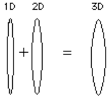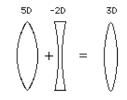Refractive power
Stronger convex lenses are fatter in the middle than weaker convex lenses and bend light inward to a greater extent; while strong concave lenses are thinner in the middle than weak concave lenses and bend light outward to a greater extent.
Given this, we can quantify how strong a lens is by looking at how well it is able to bend light. One way to do this is to send parallel rays of light into the lens, and (in the case of convex lenses) see where these rays are brought to focus.
This place where the rays come to focus is called the focal point. Clearly, the stronger the lens, the more it bends light, and therefore the closer the focal point will be to the lens. This distance from the center of the lens to the focal point is called the focal length. Lens power is measured in units called diopters. To find diopters, take 1/focal_length (with focal_length in meters). So, for instance if a convex lens brings rays of parallel light to focus 2 meters from the lens, it has a diopter value of 1/2; if 4 meters, then diopter = 1/4; if 1/10 of a meter, then diopter=10.
For concave lenses, the same logic holds, but since concave lenses can’t bring parallel light rays to focus, and instead diverge the light rays, the way that focal length is measured is to trace back these diverging rays. The place where these imaginary rays come to focus is the virtual image.
Convex lenses create real images, while concave lenses create these virtual images. So, now we can measure the focal length as the distance between the center of the lens and this virtual image. Diopter power is computed in the same was as for convex lenses, except that the distance is considered negative and therefore given a minus sign. For instance, if the distance between the center of the lens and the virtual image is 1/4 meters, then the lens is -4 diopters.
One straightforward thing with using diopters with lenses is that it makes it easy to figure out what happens when you stick lenses together in a ‘lens sandwich’. All you have to do is add the diopter values to determine what kind of lens you get. Notice in the third example, the 3d and -3d lenses just cancel out to form a sheet of glass, like a window, that neither diverges nor converges light rays.
09. Lens power: diopters
1:32 PM
Lenses vary in their ‘power’; that is, their relative ability to bend light. The more powerful the lens, the more it is able to bend light....




